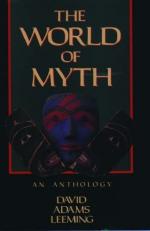
|
| Name: _________________________ | Period: ___________________ |
This test consists of 15 multiple choice questions and 5 short answer questions.
Multiple Choice Questions
1. How does Leeming say the Greeks thought of Delphi?
(a) As the center of the world.
(b) As a tourist destination.
(c) As the center of Greek power.
(d) As a business center.
2. In what way does Leeming say that Jerusalem is an unusual city?
(a) It was a sacred place to Jews, Muslims, and Christians.
(b) It resisted conquest for thousands of years.
(c) It is at the center of the ancient world.
(d) It was conquered and reconquered frequently.
3. How does Leeming say the hero's quest typically begins?
(a) The hero is challenged by an opponent.
(b) The hero leaves home.
(c) The hero is called into action.
(d) The hero discovers a special power.
4. What does Leeming say places and objects represent in myths?
(a) Actual places.
(b) Metaphors.
(c) Ancestral origins.
(d) The Great Mother.
5. Who sent the serpents that devoured the character who warned the Trojans not to accept the Greeks' wooden horse?
(a) Poseidon.
(b) Ares.
(c) Aphrodite.
(d) Zeus.
6. Where does Leeming say the garden, grove, and cave derive their sanctity?
(a) Their darkness.
(b) Their remoteness from daily human experience.
(c) Their special and different set of rules.
(d) Their relationship with the Great Mother.
7. What does Leeming say Cuchulain had upon his birth?
(a) A powerful family.
(b) A sword.
(c) Six fingers on each hand.
(d) All the powers he needed for his quest.
8. Whose story does Leeming cite as evidence of the story of the fall of a great city?
(a) Sophocles' "Oedipus Rex."
(b) Virgil's "Aeneid."
(c) Homer's "Iliad."
(d) Apollonius of Rhodes' "Argonautica."
9. What tale does Leeming describe as the epitome of the story of the loss of genitals?
(a) The story of Teiresias.
(b) The story of Medea.
(c) The story of the Argonauts.
(d) The story of the Water Jar Boy.
10. What does Leeming say that Galahad found in the Chapel Perilous?
(a) The Holy Grail.
(b) King Arthur.
(c) A giant.
(d) Sir Lancelot and Guinevere.
11. What forms does Leeming say the heroes' guides will take?
(a) Nymphs.
(b) Step-parents or stepsiblings.
(c) Animal spirits and stars.
(d) Wise men or fairy godmothers.
12. When does Leeming say heroes tend to be born?
(a) When the world is dying.
(b) In spring.
(c) Half a generation after tyrants or pests.
(d) When they are most needed.
13. How does Leeming say Buddha was conceived?
(a) He was a normal human baby.
(b) He created himself through his mother's dreams.
(c) He was conceived first as a snake.
(d) He was conceived by the sky god.
14. In Leeming's account, why are temples and cities founded on mountains?
(a) Because can see the weather and visitors coming.
(b) Because they are closest to the Supreme Being there.
(c) Because they gain status when devotees have to bring water and food.
(d) Because they can be defended better there.
15. What symbols in churches does Leeming say represent the Great Mother?
(a) Pillars.
(b) Stained glass windows.
(c) Baptismal fonts.
(d) Flying buttresses.
Short Answer Questions
1. What element does Leeming say the Water Jar Boy myth contains?
2. What qualities does Leeming say Hercules shares with many heroes?
3. How old was Joan of Arc when she first heart supernatural voices?
4. How does Leeming say most people celebrate Jerusalem?
5. What does Leeming say is similar between the myths of Hiawatha and the Buddha?
|
This section contains 591 words (approx. 2 pages at 300 words per page) |

|




